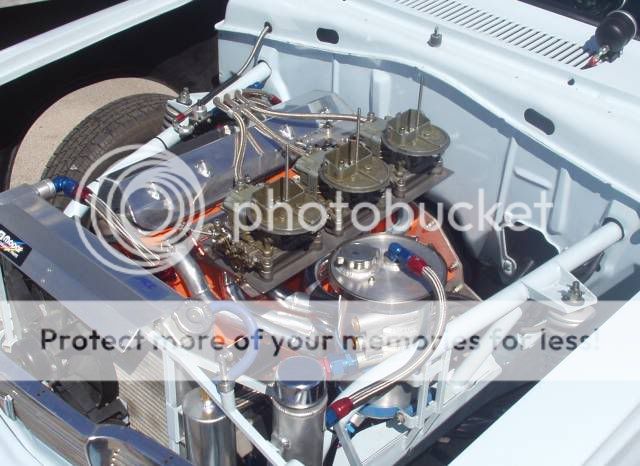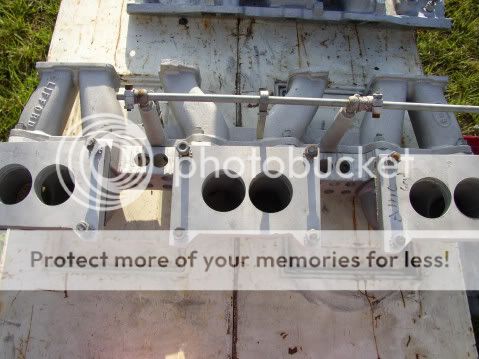I differ from most people in
how I make decisions for 200 I6 power.
This is what I've thought of in heavy print.
This is how I think it through in
small print.
The engine is a pre Clean Air Act 200 US high mount starter block. Deck it a bare minimum to get a flat face.
The cam is a 280 degree item on a 110 degree lob centre, with a lift of 500 thou with 1.6:1 roller rockers. 50 thou figures don't need to be more than 215 degrees, and the ramps need to be mild, rather than later high intensity types which ruin the valve train
1.6 roller rocker gear is best.
Begin with a stock log D8 casting log head with post 78 valves. Deck it 20 thou or so. The head needs all the Ford Six performance Handbook tricks worked on it. Port blending, short turn radius, pocket work all needs to be done with a couple of days die grinder work in store just on the intake side.
Take three Holley 2300 500 cfm carbs, and use a trifecta of Ford Six Performance Handbook Holley 2300 carb adator swaps. Jet them up for 230 hp from triple carbs. Basically, it's six 52 call size jets flowing 212 cc per minute. The carbs are all linked together all the time. They have 35 mm chokes and are 43 mm carbs.
Care of Will
was111, with a couple of extra bits on 'the side'

Use the Clifford port divider mounted to a 1/8" plate cut to match an after market gasket.Weld the divider to the adaptor. Inspect the head and see where the far too small exhast ports are. Any traditional porting will yield air becasue of the silly back cut on the cast flanges. Weld up the reverse raduis of the flanges on number 1 , 2, 5 and 6 exhast ports to allow die-grinder work to enlarge the smaller exhast ports!
The material from the top of the port needs to be wider, the base of the port needs to be wider too. The header will need wider taller exhast ports, and there needs to be a reduction in the short turn angle so the port can flow well.
The exhast pipe arrangement needs to have as little backpressure as possible. A drop in this amount of backpressure is a 7% power boost if the carb is jetted correctly. Running any of the four types of headers in useage will be the key. Pipe diameter does not need to be any more than 2" ID except over the diff and at the headers.
There should be dual out headers running under the transmount 'bump' to an H pipe, then to couple of short 12 to 18 " glass back resonators below the drive shaft. Then back to two mufflers. Any 2 1/4 to 2.5" ID mufflers which the supplier can prove flow in excess of 300 cfm at 25" Hg. The pipe diameter can stay at 2.5" over the diff, then back to any tail pipes down to 2.0 or even 1.875" internal diameter. With this set-up, back pressure registered at the header outlets will be bellow 0.7" Hg. Stock level is 6" Hg. A proper muffler will ensure pressure waves blow the exhast mix out the pipes at all times, improving mean torque with no power loss at all at maximum revs. An H pipe helps stop reversion, and makes the car sound sweeter. Little A-series Minis run 145 hp with one like this, there is no need for twin 2.5" fart cans right through, dudes.
Each group of six ports needs to be separated by a pegged in 1 1/8" alloy bar with no tranfer hole needed to ensure balance between cylinders. Peg the alloy bars in a with a set screw. Find the Holley 2300 adaptors which have two 1.6875" holes rather than the oval hole as I've shown. Valve isnerts must have a very good valve seat margin. Don't trade off extra flow figures for loss of durability past 50 000 miles. Use stock size SI valves, phosphor bronze guides, and a set of very strong aftermarket hardened 7.875" pushrods which have ends which mirror the stock ones, but are not hit by the rockers at full lift. Pushrod height must follow the 90 degrees right angle at 50% of maximum camhaft (not valve) lift rule.
Use ACL Race 6MKRY9413 flat top 0.0 cc pistons. Other option is
Inliner's or
AzCoupe's aftermaket forged pistons. Some of the boys down south have 1.04" tall pistons which measn you need no thick spacer plate, but they do cost more. The ACL's are race spec items based on European BMW/ Opel Mahle technology, used on Aussie Ford Falcon circuit racers and hot road cars. This is a 2 ring Eutectic piston, which is 10:1 compression needing 93 octane with this cam choice . It has a 1.163" deck, and fits to the Lima 2.3 OHC rods from any of the hot turbo Fords. Rod loads are reduced by 10% for a 5% power increase. Adapt a 100 amp Toyota Hilux 3.0 Diesel alternator, which has a 5 cfm vaccum pump on the back, and feed it from a 1/2" pipe from the old outage pipe under No 1 spark plug. Direct from the alternator to a sealed blow by can (coffe tin size) via emission hose. Place a vented K&N oil filler on it. This will take blowby out of the sump and allow any atomised oil to settle out to be emptied periodically. There is over 5 cfm of blow by coming out of the sump at 5500 rpm, and removing blow-by in the combustion chamber allows 5% boost in peak power because rings gaps can be set wide, and there is no charge dillution.
With this combo, the piston comes out 123 thou out of the block, which is too much. Use this cheaper piston with a CNC machined 62.5 thou steel gasket which is linked with a 40 thou compressed composite gasket on the block, and then to a stock 25 thou steel gasket on the top. Both must have no ledging. They should have the fire ring at 3.81" on most new gaskets.
Use 14 new lubricated 200 bolts and tighten the new bolts up in stages.
A high volum oil pump, Hi Energy baffled sump, a Duraspark II, good American tri metal bearings, a lubricant to suit your locality.
If you are not converting to a neoprene seal, make sure you follow the rope seal protocols. The vacuum pump will reduce main seal leakage, and if you follow the rules, it'll be a low drag item after the first 5000 miles of run in.
Use a proper V8 T5 close ratio adaptor kit, and look at a better clutch. The best diff ratio for quarter mile drags at 6000 rpm in top is is 4.3:1 from a Toyota Hi Lux pick-up, but a 5 speed can just as easily use 3.25 with 24" tires or 3.45 to 3.5:1 with 26" with wheel heights varing from 24 to 26". Each inch you go up from 24", go up 0.18:1 The stock post 1992 ones are often 3.9, or may be 4.88 in an early SR5, so hunt arround. They use 31 spline axles, limited slip, 5 stud brakes, big drums and are very tough and can handle the stock Mustang leafs if its pre 68. A 9" diff may be an option for later cars, or 7.5 or 8.8" Fox or Ranger diffs with traction locks of some kind.
This combo is conservatively rated at only 230 hp at 5500 rpm, 230 lb-ft at 3900 rpm. There is the distinct possiblity that 245 hp and lb-ft could be had at the same revs. The torque curve is modest at 1000 to 2500 rpm, but that's still exceeds the stock 200 from 2500 rpm on. Effective compression is way up on the stock engine, and proper carburation will make this an eruptive engine when stirred, but finely progressive acceleration when idled. The key to this engine is minimal disturbance. Port on port intake systems are the way top make power on log heads. They allow streetable cams with a satisfying increase in low end torque.
Port on port induction mitigates against the 90 degree bends which kill log heads over 165 hp. 25% more power is possible just by having the same jetting as one carb. When the single point of dispension is redistributed over 6 points of discharge, it creates the evirnoment for a perfect fuel air mixture. It's the cheapest improvement above 170 hp for any 200 cube log engine. It makes a normally latent, poor breathing engine respond to the throttle much more quickly. Response to throttle is a measure of specific power. It also allows the stock mixture distribution (which gives a 2:1 air fuel ratio bias in favour of number 3 and 4 and a lean condition to 1 2, 5 and 6) to be eliminated, allowing more power. Basically, you are making a cheap set of IDA or IDF Webers like the Argentines use on the Todo website.


